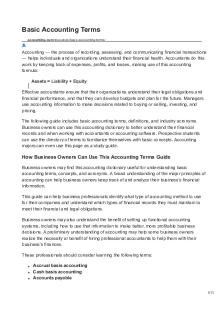Accounting 101 Midterm Review Sheet PDF

| Title | Accounting 101 Midterm Review Sheet |
|---|---|
| Course | Introduction To The Theory And Practice Of Accounting I |
| Institution | Queens College CUNY |
| Pages | 2 |
| File Size | 54.1 KB |
| File Type | |
| Total Downloads | 38 |
| Total Views | 169 |
Summary
midterm review...
Description
Accounting 101 Midterm Review Sheet Chapter Two -
Journal 1. Arrange transactions of the same nature 2. Record transactions chronologically 3. Shows debits and credits of a transaction
-
Ledger 1. Has distinctive T accounts 2. Name of account appears at the top of the entry 3. Account are balanced regularly
-
Balance Sheet = Snapshot of assets liabilities and owner’s equity at a certain time
-
Income Statement = period of time and shows revenue, expenses and net income
-
Dividends = money paid to shareholders out of the company’s reserves or profits
-
Generally Accepted Accounting Principles = Standard framework of guidelines for financial accounting
Accounting Principles Realization – Revenue can only be recognized once the underlying goods or services associated with the revenue have been delivered or rendered (earned) Matching Principle = Expenses should be recorded during the period in which they are incurred regardless of when the transfer of cash occurs Going Concern Principle = A company or other entity will be able to continue operating for a period of time that is sufficient to carry out operations Cost Principle = Requires that assets be recorded at the cash amount at the time that an asset is acquired Adequate Disclosure = Financial statements should provide comprehensible and a clear description of a company’s financial position Stable Dollar Principle = Inflation will not be accounted for in financial statements Concept of the Business Entity = the transactions of a business must be seperte from its owners’ personal business
Know all the I, D and NE’s -
Assets = Liabilities + OE
-
Equity = An owner’s interest in the company
-
Retained Earnings is recorded under an equity account
-
Net Income = Income minus cost of goods sold
-
Revenue = Income (Not minus costs of goods sold)
-
Accumulated depreciation is a contra asset account
Four adjusting Journal Entries 1. 2. 3. 4.
Assets to Expenses Liabilities to revenue Accruing Expenses Accruing Revenue
-
You can find net income by finding the company’s beginning and ending retained earnings and dividends for the year Subtract beginning RE by ending RE then add dividends paid to get NI
-
Difference between General Ledger and General Journal 1. -
Journal Books of original entry Recorded in order by date The journal contains the accounts to be debited and credited and the amounts Once the transaction is recorded in the general journal, the amounts are then posted to the appropriate accounts All these accounts are under one section and in chronological order
2. General Ledger - Accounts such as Cash, AR, Equipment, AD, AP are recorded in the general ledger - These accounts are separated one by one
Current Asset = Cash and other assets that are expected to be converted to cash within a year...
Similar Free PDFs

Accounting 101 for review
- 21 Pages

Midterm Review Sheet
- 6 Pages

Midterm 1 Review Sheet
- 3 Pages

Humcore midterm review sheet
- 6 Pages

Anthro 1100 Review Sheet Midterm
- 2 Pages

BBH 101 Exam 1 Review Sheet-2
- 6 Pages

Accounting Midterm
- 30 Pages

Urban Studies 101 midterm
- 13 Pages
Popular Institutions
- Tinajero National High School - Annex
- Politeknik Caltex Riau
- Yokohama City University
- SGT University
- University of Al-Qadisiyah
- Divine Word College of Vigan
- Techniek College Rotterdam
- Universidade de Santiago
- Universiti Teknologi MARA Cawangan Johor Kampus Pasir Gudang
- Poltekkes Kemenkes Yogyakarta
- Baguio City National High School
- Colegio san marcos
- preparatoria uno
- Centro de Bachillerato Tecnológico Industrial y de Servicios No. 107
- Dalian Maritime University
- Quang Trung Secondary School
- Colegio Tecnológico en Informática
- Corporación Regional de Educación Superior
- Grupo CEDVA
- Dar Al Uloom University
- Centro de Estudios Preuniversitarios de la Universidad Nacional de Ingeniería
- 上智大学
- Aakash International School, Nuna Majara
- San Felipe Neri Catholic School
- Kang Chiao International School - New Taipei City
- Misamis Occidental National High School
- Institución Educativa Escuela Normal Juan Ladrilleros
- Kolehiyo ng Pantukan
- Batanes State College
- Instituto Continental
- Sekolah Menengah Kejuruan Kesehatan Kaltara (Tarakan)
- Colegio de La Inmaculada Concepcion - Cebu







